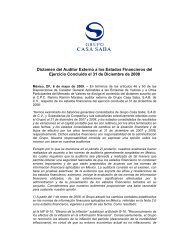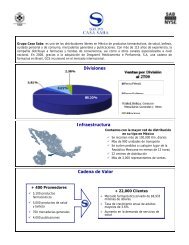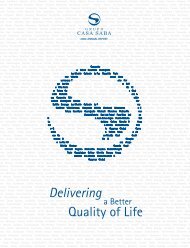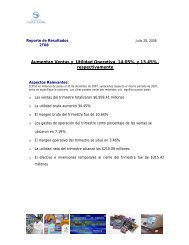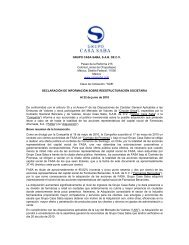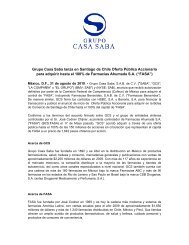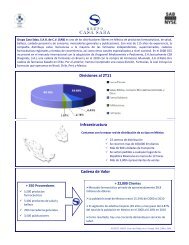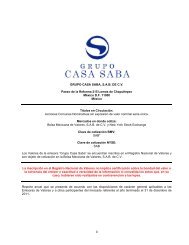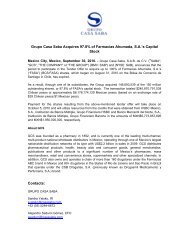FORM 20-F Grupo Casa Saba, S.A.B. de C.V.
FORM 20-F Grupo Casa Saba, S.A.B. de C.V.
FORM 20-F Grupo Casa Saba, S.A.B. de C.V.
Create successful ePaper yourself
Turn your PDF publications into a flip-book with our unique Google optimized e-Paper software.
Table of Contents<br />
With the acquisition of Drogasmil in Brazil in May <strong>20</strong>08 and the subsequent purchase of FASA in October <strong>20</strong>10, approximately 22% of our consolidated net sales in<br />
<strong>20</strong>11 resulted from sales to parties located outsi<strong>de</strong> of Mexico. In the past, inflation has led to high interest rates and <strong>de</strong>valuations of the Peso. Inflation itself, as well as governmental<br />
efforts to reduce inflation, has had significant negative effects on the Mexican economy in general and on Mexican companies, including us, in particular. One result of inflation in<br />
Mexico is the <strong>de</strong>crease in the real purchasing power of the Mexican population, which can lead to a <strong>de</strong>crease in the <strong>de</strong>mand for the products that we distribute and/or sell. In addition,<br />
the Mexican government’s efforts to control inflation by tightening the monetary supply have historically resulted in higher financing costs as real interest rates have increased. Such<br />
policies have had and could have an adverse effect on our business, financial condition and results of operations.<br />
Brazil and, to a lesser extent, Chile have historically had high inflation and interest rates. The impact of high inflation rates and high interest in these countries could<br />
have adverse effects in our operations in such country. Consumer <strong>de</strong>mand could <strong>de</strong>crease as purchasing power <strong>de</strong>clines and access to their respective credit markets could become<br />
more difficult and at high interest rates.<br />
In Brazil, the annual inflation rate was 6.5% in <strong>20</strong>11, somewhat higher than the 4.5% target set by the Central Bank while annual GDP growth was 2.7%, stimulated<br />
primarily by agriculture and internal <strong>de</strong>mand which was driven by the country’s robust labor market, lower bowering costs and a reduction in the industrial production tax on select<br />
consumer goods. Lower GDP growth can be attributed to a combination of external factors such as the Eurozone crisis as well as internal factors such as rising inflation. In <strong>20</strong>11, the<br />
Selic averaged 11.67%, down from its peak of 12.5% in July.<br />
In <strong>20</strong>11, the Chilean economy posted an annual GDP growth of 6.3%, its fastest pace since 1997 and annual inflation was 4.4%. The labor market is tight as the<br />
unemployment rate dropped to 6.6% at the end of December, which could potentially put pressure on prices in the future, causing inflation to rise.<br />
Introduction to Our Operations<br />
The following table sets forth the real price increases and unit volume growth for our Private Pharma division for the years indicated:<br />
Year En<strong>de</strong>d December 31,<br />
<strong>20</strong>09 <strong>20</strong>10 <strong>20</strong>11<br />
Total Mexican Private Pharmaceuticals Market:<br />
Real Unit Price Increases (0.4%) (2.3%) (4.2%)<br />
Growth in Units (2.5%) 0.7% 5.5%<br />
<strong>Casa</strong> <strong>Saba</strong> Private Pharmaceutical Distribution:<br />
Real Unit Price Increases 3.1% (5.9%) 2.3%<br />
Growth in Units (5.8%) 3.9% (6.7%)<br />
Market Share of <strong>Grupo</strong> <strong>Casa</strong> <strong>Saba</strong>(1): 22.9% 23.6% <strong>20</strong>.9%<br />
Inflation:(2) 3.6% 4.4% 3.8%<br />
(1) Based on information from IMS Health, A.G. (Mexico) and <strong>Grupo</strong> <strong>Casa</strong> <strong>Saba</strong>’s own estimates. This market share does not inclu<strong>de</strong> purchases ma<strong>de</strong> by government institutions<br />
and sales in the private pharmaceutical market related to pharmaceutical products with the same active ingredient but are not bran<strong>de</strong>d by any particular laboratory (similares),<br />
generics and, generic products that are recommen<strong>de</strong>d to clients by pharmacy employees at the point-of-sale or by the dispensing physician (impulse). Also inclu<strong>de</strong>s an IMS<br />
estimate of sales through non-wholesalers.<br />
(2) Based on the changes in the NCPI.<br />
64



